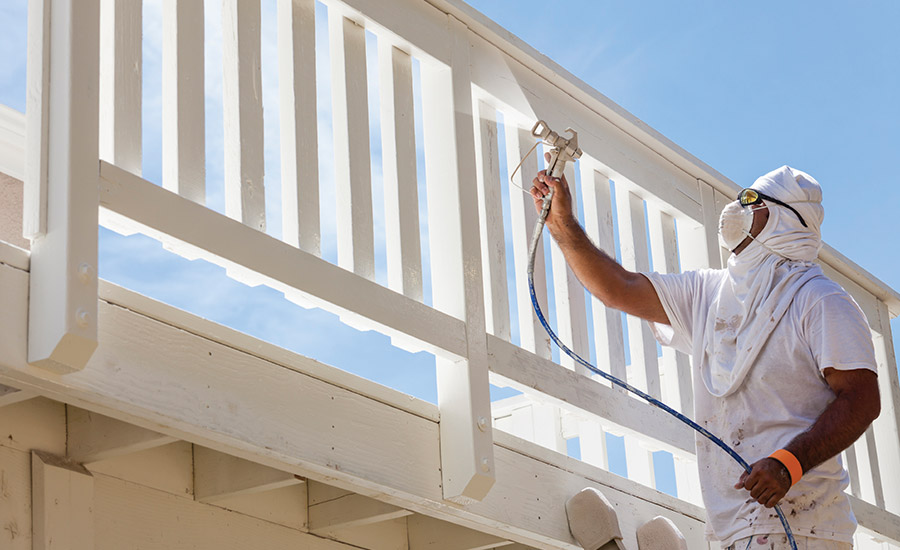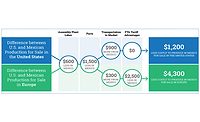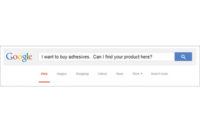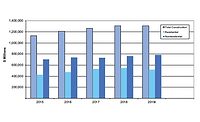Available through the U.S. Green Building Council’s Leadership in Energy and Environmental Design (LEED®) program, LEED v4 is the newest iteration of a benchmark standard for high-performance green buildings. The LEED v4 standard is vastly different from its predecessor (LEED v2009) with respect to volatile organic compound (VOC) emissions compliance in building construction. Eligibility for earning a LEED v4 “Low-Emitting Materials” credit requires that a project team have the collective body of knowledge and experience to stay below the required threshold emission levels of interior coatings applied on-site in a residential or commercial construction project, combined with three other interior low-emitting material categories: adhesives and sealants; flooring systems; and composite wood. Hospital and school construction projects have added criteria that must be factored into emissions threshold levels to include the category of ceilings, walls, thermal, and acoustic insulation, as well as that of exterior applied products.
Within a building interior, the threshold levels of LEED v4 compliance include total VOC emissions, as well as “general emissions.” Achieving the “Low-Emitting Materials” credit earns a project team up to three points toward certification under the new rating system.
Can a lack of product knowledge when combining the stated three low-emitting materials be a barrier to attaining the credit on certain projects? Is the typical project team equipped with individual(s) who have adequate knowledge of both adhesives and coatings technologies to properly evaluate interior applied products, given that traditionally these products are used by different types of applicators and end users? An understanding of to what degree coatings practitioners (e.g., painting contractors) lack the necessary information on adhesives products to properly assess adhesives’ emissions when pursuing the “Low-Emitting Materials” credit is necessary. Moreover, what steps can be taken to ensure the appropriate information is accessible to those who need it?
Involving the Entire Team
David Ryker, chair of the Board of Directors for the Painting and Decorating Contractors of America (PDCA), believes these questions may have merit for PDCA members. PDCA comprises a diverse membership of 2,000 contractors in the U.S. and Canada that specialize in residential, commercial, and industrial painting. From a marketing standpoint, some of the owners of the contracting firms that belong to PDCA—those principally involved in commercial painting as opposed to residential painting—like the idea of having a successfully completed green building project for the professional credential that it earns them. In fact, Ryker, founder of the Midwest Decorating Co. Inc., a mid-sized commercial painting contracting firm based in Indianapolis, Ind., that has been owned and operated by the Ryker family since 1966, periodically encounters the need for green building credentials in his own business.
Given that PDCA’s main thrust, according to Ryker, is education and training for its contractor members, delivered through expos and PDCA’s online Contractor College, it may make sense to investigate the need for adhesives product information for PDCA members (as well as similar organizations that serve the needs of coatings practitioners) to satisfy the LEED v4 “Low-Emitting” Materials credit requirement.
Adhesives and sealants manufacturers need to first understand how a project team typically makes its product decisions. Is it the building owner who is making the decisions, or the architect/designer? While the building owner will need to stay informed on all decisions related to the construction project, the final decision is far more likely to be made by the “AP” (accredited professional). The AP, with varying degrees of knowledge and prior experience specifying adhesives and coatings, will either contact vendors directly with questions pertaining to the materials and their respective ingredients, or do their research online.
Ultimately, the size of the project budget determines the types of professionals who can be hired and, subsequently, the methodology by which those professionals assess emissions threshold levels that influence adhesive and sealant product buying decisions.
Any views or opinions expressed in this column are those of the author and do not represent those of ASI, its staff, Editorial Advisory Board or BNP Media.
Future Columns
This is the first installment in a series exploring the adhesive products’ informational needs of LEED v4 team members. Future columns may address:
• What are the key questions of the AP (accredited professional) users of adhesives—and do the adhesive applications extend beyond flooring and carpet tiles?
• Would this community use an online library of product information? If so, where would users expect to find it? (i.e., a website associated with LEED v4, PDCA, adhesives.org, or elsewhere?)
• What type of adhesives and sealants product information (if any) is being sought by building owners, architects, designers, inspectors, coatings applicators, building occupants, or any other type of individual or group associated with LEED v4, or general construction?
• Would an online adhesives/sealant selector tool, an adhesives CAD symbol, or information on best bonding practices (to include bonding dissimilar substrates), be of value?




